|

Do you ever think about tracing the footsteps of your favorite author...Hemingway's
Cuba, Faulkner's's south, Thereau's Walden? It can be a real thrill
to see the locations they've written about...and the places that molded
the authors themselves. Judie Fein followed a girlhood dream by taking
a journey to Haworth, England to explore the home and pay tribute
to some old friends...the Brontë sisters.
Literary
Heaven
At Home with the Brontës
By Judith Fein
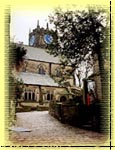 It's a gray, dismal, rainy day in northern England. What a perfect time
to visit that bastion of gothic girlhood--where the Brontë sisters
lived, wrote, repressed their emotions and most of them died. Haworth
is the ideal location for romantics who have read and loved Charlotte
Brontë's Jane Eyre, Emily Brontë's Wuthering Heights
or Anne Brontë's The Tenant of Wildfell Hall. I am a Brontë
nut, and, dreaming of the wild and passionate character of Heathcliff,
I arrive in front of the old Brontë homestead. I am immediately
swept back l50 years in time.
It's a gray, dismal, rainy day in northern England. What a perfect time
to visit that bastion of gothic girlhood--where the Brontë sisters
lived, wrote, repressed their emotions and most of them died. Haworth
is the ideal location for romantics who have read and loved Charlotte
Brontë's Jane Eyre, Emily Brontë's Wuthering Heights
or Anne Brontë's The Tenant of Wildfell Hall. I am a Brontë
nut, and, dreaming of the wild and passionate character of Heathcliff,
I arrive in front of the old Brontë homestead. I am immediately
swept back l50 years in time.
It's
Sunday and in front of the stone church, where the Brontës' austere
father, Reverend Patrick Brontë, presided, there is a local band
accompanying a modern-day preacher. I can picture the three little girls
standing here, enthralled. The parishioners look down at their well-worn
song books, and they begin to sing.
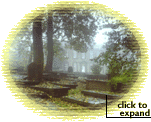 Their voices waft over the graveyard that the girls walked through every
day.
Their voices waft over the graveyard that the girls walked through every
day.
"I see around me tombstones grey
Stretching their shadows far away.
Beneath the turf my footsteps tread
Lie low and lone the silent dead....."
It's
these tombstones that fueled the girls' imaginations, offering up character
names and telling tales of infant mortality, typhoid and personal tragedy.
The Brontë home, otherwise known as The Parsonage, is open to tourists.
Inside, everything has been preserved intact. There's the piano the
girls played, the dining room table which Charlotte, Emily and Anne
circled as they read and critiqued each othres' writing at night. I
remember the impact the house had on Emily:
"There
is a spot 'mid barren hills
Where winter's howls and driving rain,
But if the dreary tempest chills
There is a light that warms again.
The
house is old, the trees are bare
And moonless bends the misty dome
But what on earth is half so dear--
So longed for as the hearth of home?"
I sigh
at the sofa where Emily died, concealing her tuberculosis until hours
before her demise. And there's the back kitchen, which Charlotte described
nostalgically in a letter to Emily in l843:
"I should like...to be cutting up the hash, and you standing by, watching
that I put enough flour, and not too much pepper, and, above all,
that I save the best pieces of the leg of mutton for Tiger and Keeper,
the first of which personages would be jumping about the dish and
carving-knife, and the latter standing like a devouring flame on the
kitchen floor. To complete the picture, Tabby blowing the fire, in
order to boil the potatoes to a sort of vegetable glue!"
We visit
Charlotte's room with her tiny, delicate dresses, mittens and boots.
Perhaps the greatest thrill is looking at the astounding books the girls
wrote as children. They are about an inch-and-a half tall, covered with
thousands and thousands of words in handwriting so minuscule that the
girls almost went blind from creating them.
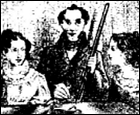
|
Drawing by Branwell.
(L-R) Charlotte, Branwell, Anne |
As we go
through the Parsonage, we learn about the "other" Brontë-- brother
Branwell, an artist, poet and consummate sufferer, who, by the way, has
lately garnered quite a fan club of his own. Branwell bucked convention
and slipped into a dissolute life of alcohol and opium. We exit the house
and visit his nearby watering hole.
The locals
don't like to speak ill of the Brontës, but the pub manager does
give us a hint of what went on back in those Victorian days.
The manager: "We're in the Black Bull pub, in Haworth, where
Branwell spent some of his darkest hours. He'd often be among the
last customers to go home in the wee hours....."
By now
the Sunday service has ended, and we enter the dark, dank church. A
group is gathered in sad silence near the main altar, and a plaque informs
us that this is where Charlotte and Emily are buried, under the flagstone.
Because
we have arrived on a Sunday, it's hard to find anyone to speak about
the Brontës, but I did manage to get Robert Barnard, chairman of
the Brontë society, on the phone. He has a theory about why there's
still so much interest in the Brontës after l50 years.
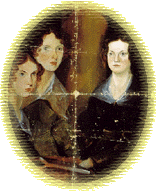
|
Painting of (L to R) Anne, Charlotte and Emily by Branwell Brontë,
c. 1834
At the National Portrait Gallery, London |
Robert: "I think the novels touch a chord in people. They are
Romantic, they are Gothic. As my mother-in-law said, every woman should
have a Heathcliff in her life. She meant that a passion of that sort--an
overmastering passion between two people-- is something everyone should
experience. My mother-in-law would have worn Heathcliff down to a frazzle."
Judie:
"What do people react to most when they come to Haworth? What gets
the most emotional responses?"
Robert:
"I think it is the Parsonage. I sometimes stand upstairs--I like to
do it in the late afternoon, when the crowds thin out. I hear people
coming out of one of the rooms saying it's incredible. It really is
what they wanted from the house, what they've always imagined the
house to be like."
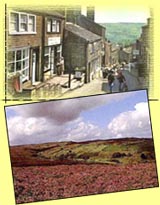 Although it is now a popular tourist destination, the town of Haworth
still has the original shops, the cobblestone streets and the school
building where Charlotte taught. On the outskirts of the city are bridges,
castles and buildings that inspired the settings in many of the Brontë
novels. But there's nothing quite like taking off your shoes and running
through the moors that Emily loved so well.
Although it is now a popular tourist destination, the town of Haworth
still has the original shops, the cobblestone streets and the school
building where Charlotte taught. On the outskirts of the city are bridges,
castles and buildings that inspired the settings in many of the Brontë
novels. But there's nothing quite like taking off your shoes and running
through the moors that Emily loved so well.
Robert: "The moors turn purple around August or September time
and then the moorland become a great blanket of purple--an astonishing
sight. Emily's first mature poem was about this heather waving in
the breeze."
English
voice: "The moors seen at a distance, broken into cool dusky dells;
but close by, great swells of long grass undulating in waves to the
breeze; and woods and sounding water, and the whole world awake and
wild with joy."
This
is Judie Fein, in literary heaven in Haworth, for the Savvy Traveler.
For
More Information
Brontë
Country Tourism
Brontë
Country
Want
to take your own literary tour?
Bookadventures.com
offers literary tours, including:
- West
Country Wonderlands: A Storytour of Children's Literature in England's
Cornwall, Devon and Somerset (July 15-28, 1999).
- Jane
Austen: Pastimes & Pleasures (June 21-July 2, 1999).
- Scene
of the Crime: A Book Adventures Tour Investigating Mystery Writers
of England (August 12-23, 1999).
The Literary
Traveler is a quarterly newsletter where you can "explore the world
of your literary imagination." A variety of literary tours throughout
the United States are described.
InfoHub offers several packages, with literary tours throughout England.
|





 It's a gray, dismal, rainy day in northern England. What a perfect time
to visit that bastion of gothic girlhood--where the Brontë sisters
lived, wrote, repressed their emotions and most of them died. Haworth
is the ideal location for romantics who have read and loved Charlotte
Brontë's Jane Eyre, Emily Brontë's Wuthering Heights
or Anne Brontë's The Tenant of Wildfell Hall. I am a Brontë
nut, and, dreaming of the wild and passionate character of Heathcliff,
I arrive in front of the old Brontë homestead. I am immediately
swept back l50 years in time.
It's a gray, dismal, rainy day in northern England. What a perfect time
to visit that bastion of gothic girlhood--where the Brontë sisters
lived, wrote, repressed their emotions and most of them died. Haworth
is the ideal location for romantics who have read and loved Charlotte
Brontë's Jane Eyre, Emily Brontë's Wuthering Heights
or Anne Brontë's The Tenant of Wildfell Hall. I am a Brontë
nut, and, dreaming of the wild and passionate character of Heathcliff,
I arrive in front of the old Brontë homestead. I am immediately
swept back l50 years in time. 


 Although it is now a popular tourist destination, the town of Haworth
still has the original shops, the cobblestone streets and the school
building where Charlotte taught. On the outskirts of the city are bridges,
castles and buildings that inspired the settings in many of the Brontë
novels. But there's nothing quite like taking off your shoes and running
through the moors that Emily loved so well.
Although it is now a popular tourist destination, the town of Haworth
still has the original shops, the cobblestone streets and the school
building where Charlotte taught. On the outskirts of the city are bridges,
castles and buildings that inspired the settings in many of the Brontë
novels. But there's nothing quite like taking off your shoes and running
through the moors that Emily loved so well.